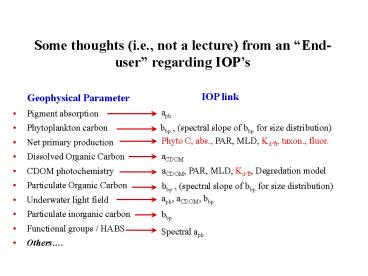GLAS profile data
1 / 19
Title: GLAS profile data
1
Some thoughts (i.e., not a lecture) from an
End-user regarding IOPs
IOP link
- Geophysical Parameter
- Pigment absorption
- Phytoplankton carbon
- Net primary production
- Dissolved Organic Carbon
- CDOM photochemistry
- Particulate Organic Carbon
- Underwater light field
- Particulate inorganic carbon
- Functional groups / HABS
- Others.
GLAS profile data
aph
bbp , (spectral slope of bbp for size
distribution)
Phyto C, abs., PAR, MLD, Kd?, taxon., fluor.
aCDOM
aCDOM, PAR, MLD, Kd?, Degredation model
bbp , (spectral slope of bbp for size
distribution)
aph, aCDOM, bbp
bbp
Spectral aph
2
How good do the IOP products have to be?
Uncertainties ? Biases ? The answer to
this question is very much dependent upon
the question to be answered
3
What is global annual ocean NPP?
OC-3 47.8 Pg C y-1 QAA 48.6 Pg C y-1 GSM 45.3
Pg C y-1
4
but regional differences can be important,
depending on the question of interest?
OC-3 vs GSM Difference
norm. diff.
CDOM
m-1
5
How does ocean biology change?
An issue of temporal trends within a given
algorithm
6
Wavelength ratio spectral matching chlorophyll
Year date
7
Wavelength ratio algorithm chlorophyll
Spectral matching algorithm chlorophyll
Year date
8
SMA WRA
Surface Chlorophyll Anomaly
Year since 1997
9
(No Transcript)
10
however, SMA are more susceptible to artificial
trends resulting from drifting sensor data
11
Why is ocean biology changing?
Biomass
Chlorophyll
Physiology
12
Some additional thoughts
uncertainties in IOP products become more
important when properties of interest are
investigated using ratios of two
biomass-dependent properties.
winter
Winter scene
Fsat / chl
here, a very small bias in FLH (0.001 mW cm-2
µm-1 sr-1) causes central ocean gyres to light
up.
13
This End-users Perspective
it is not so much the improved accuracy of the
IOP products over traditional WRAs that make
them so attractive, it is more the increased
diversity of products, their fundamental nature,
and their internal consistency that makes SMAs
preferred. e.g., pigment vs absorption, bbp to
carbon biomass, bbp slope to characterize
particle size distribution, functional group
capabilities, etc
- How do IOP uncertainties vary over time space?
- SMAs sensitive to radiometric error more than
WRAs - Relative uncertainty can be more important the
absolute - How do IOP uncertainties compare to other
sources of uncertainty in the derivation of key
geophysical properties?
14
Backup Slides
15
WRA 1
SMA 1
SMA 2
16
(No Transcript)
17
Biomass physiology from space
Chlorophyll
- Physiology can dominate and is
- functionally linked to physical
- environment (SST, strat)
- ChlC vs NPP relationship varies
- in magnitude and sign
Biomass
Physiology
18
Separating light- and nutrient effects
- and it is here where a clear opportunity
arises for integrating detailed understanding of
physiology into regional to global analyses
Physiology
Photoacclimation
Nutients, other
19
Chlorophyll
winter
Winter scene
Fsat / chl































